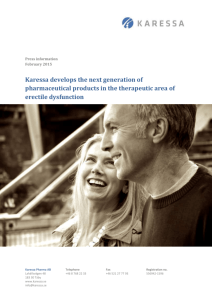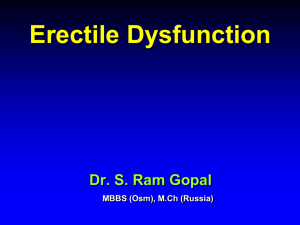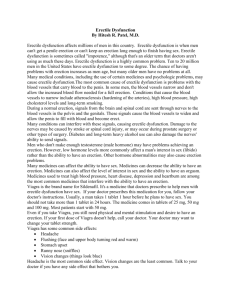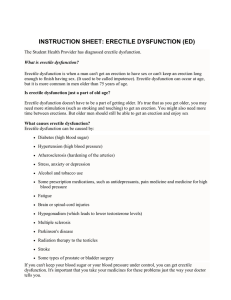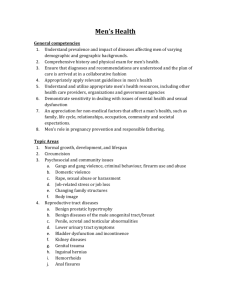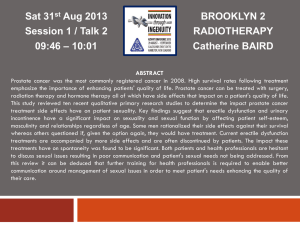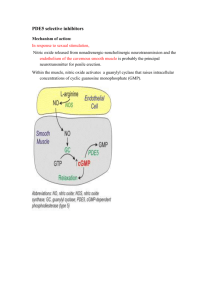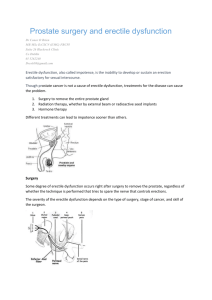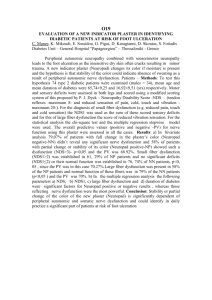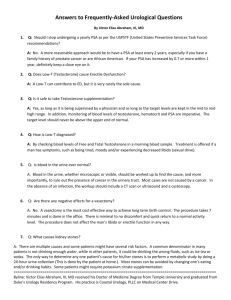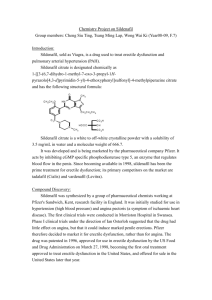Erectile Dysfunction 2014
advertisement
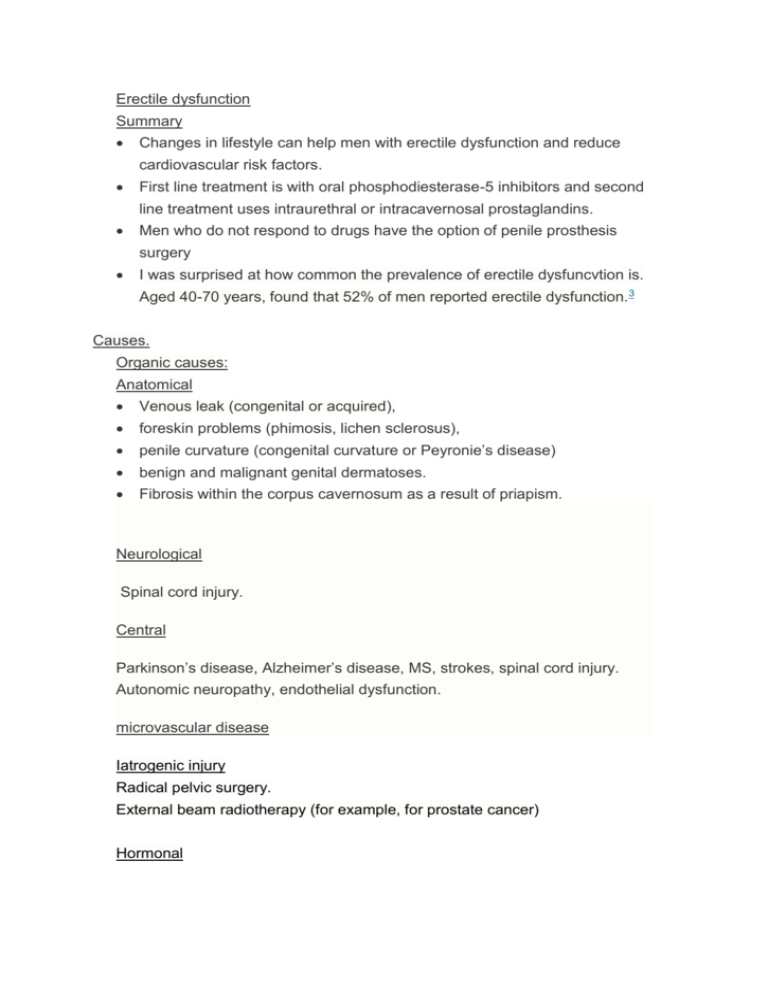
Erectile dysfunction Summary Changes in lifestyle can help men with erectile dysfunction and reduce cardiovascular risk factors. First line treatment is with oral phosphodiesterase-5 inhibitors and second line treatment uses intraurethral or intracavernosal prostaglandins. Men who do not respond to drugs have the option of penile prosthesis surgery I was surprised at how common the prevalence of erectile dysfuncvtion is. Aged 40-70 years, found that 52% of men reported erectile dysfunction. 3 Causes. Organic causes: Anatomical Venous leak (congenital or acquired), foreskin problems (phimosis, lichen sclerosus), penile curvature (congenital curvature or Peyronie’s disease) benign and malignant genital dermatoses. Fibrosis within the corpus cavernosum as a result of priapism. Neurological Spinal cord injury. Central Parkinson’s disease, Alzheimer’s disease, MS, strokes, spinal cord injury. Autonomic neuropathy, endothelial dysfunction. microvascular disease Iatrogenic injury Radical pelvic surgery. External beam radiotherapy (for example, for prostate cancer) Hormonal Primary and secondary hypogonadism resulting in very low free and total testosterone values are associated with a reduction in sexual libido and erectile dysfunction. Hyperprolactinaemia (commonly related to antipsychotic drugs) inhibits the release of gonadotrophin releasing hormone, leading to hypogonadotrophic hypogonadism. hyperthyroidism through increases in the sex hormone binding globulin concentration and reduced free testosterone levels. Common prescription and recreational drugs associated with erectile dysfunction Antidepressants Selective serotonin reuptake inhibitors Monoamine oxidase inhibitors Tricyclic antidepressants Antihypertensives β blockers Verapamil Methyldopa Clonidine Guanethidine Cardiac drugs Digoxin Amiodarone Diuretics Spironolactone Thiazide Hormonal Antiandrogens (flutamide, cyproterone acetate) Luteinising hormone releasing hormone agonists (leuprorelin, goserelin) 5α reductase inhibitors Corticosteroids Ketoconazole Histamine receptor 2 antagonists Cimetidine Ranitidine Recreational drugs Alcohol, marijuana, cocaine cardiovascular disease—for example, obesity, metabolic syndrome, smoking, lack of exercise, diabetes, and hypercholesterolaemia What lifestyle factors are associated with erectile dysfunction? Smoking biking for more than three hours a week sedentary lifestyle How should patients with erectile dysfunction be assessed in primary care? Ask men with diabetes, CVD & LUTS about erectile dysfunction. Identify risk factors: diabetes, hypogonadism and lifestyle factors: excessive alcohol, smoking, recreational drugs, and lack of regular exercise. Sexual history :onset & pattern of erectile dysfunction in the current or previous sexual relationship and whether it is due to a lack of rigidity or early detumescence. Ejaculatory dysfunction, penile curvature, and orgasmic dysfunction need to be identified because these conditions require an alternative treatment algorithm. There are validated psychometric questionnaires: International index of erectile function or the sexual health inventory for men. What clinical examination is necessary? penis: to check for the penile abnormalities Secondary sexual characteristics: testicular size, and testicular consistency (a good indicator of primary hypogonadism). prostate is considered in older men with prostate symptoms or ejaculatory dysfunction. BP, heart rate, waist circumference, and BMI Investigations lipids, fasting glucose, HbA1c, Total testosterone, L.H, and sex hormone binding globulin. PSA test: only if the digital rectal examination result is abnormal and the patient is over 50 years (if he is requesting screening or has risk factors for prostate cancer) or if testosterone replacement is considered. What treatments are available in primary care? Lifestyle modifications regular exercise, smoking cessation weight loss Herbal only three herbal remedies have published data from studies in humans—Panax ginseng,23 Butea superba,24 and yohimbine.25 Medication First line: Phosphodiesterase (PDE) inhibitors. Contraindicated In patients on nitrates or vasodilatation or sexual activity is inadvisable, and in those with a history of non-arteritic optic neuropathy. Caution Renal or hepatic impairment, recent stroke, myocardial infarction, or unstable angina and in those taking α blockers for lower urinary tract symptoms. common side effects sildenafil headache, flushing, dyspepsia, and rhinitis. The adverse effects with tadalafil and vardenafil are similar to sildenafil, although tadalafil is associated with a higher incidence of back pain and myalgia.27 Most common oral phosphodiesterase type 5 inhibitors used as first line treatment of erectile dysfunction in primary care Time to Oral drugs Dose (mg) Sildenafil citrate (Viagra) Tadalafil (Cialis) 25-100 on demand 5 daily or 10-20 on demand 10-20 on demand Vardenafil hydrochloride (Levitra) onset Half Duration of (min) life (h) action (h) 30-60 4 4-8 45 17.5 24-36 25-40 4-5 6 Conditions for which patients are eligible for an NHS prescription for treatment of erectile dysfunction Diabetes Multiple sclerosis Parkinson’s disease Poliomyelitis Prostate cancer Prostatectomy (radical or transurethral resection) Radical pelvic surgery Renal failure treated by dialysis or transplant Severe pelvic injury Single gene neurological disease Spinal cord injury Spina bifida Reasons for referral to secondary care Penile abnormality (phimosis, Peyronie’s disease, post-priapism, penile cancer) Endocrinopathy (primary or secondary hypogonadism) Severe mental distress First line pharmacotherapy ineffective Psychogenic erectile dysfunction refractory to first line drugs Specialised diagnostic tests needed (for example, penile Doppler studies, nocturnal penile tumescence) Intermediate or high risk cardiovascular disease Contraindication to phosphodiesterase-5 inhibitors Lifelong history of erectile dysfunction Intracavernosal injections and transurethral prostaglandins. Testosterone replacement is licensed for use only in men with hypogonadism, which is defined as a clinical syndrome caused by androgen deficiency that may adversely affect multiple organ functions and quality of life. Hypogonadism can be caused by testicular failure (primary) or disruption of the hypothalamic-pituitary-gonadal axis (secondary). It is initiated in secondary care. Men started on testosterone replacement require monitoring of prostate specific antigen, full blood count, and liver function tests annually. Intracavernosal and intraurethral prostaglandins The synthetic prostaglandin E1 analogue alprostadil can be given as second line treatment. Alprostadil increases intracellular concentrations of cyclic AMP (cAMP), resulting in relaxation of smooth muscle. Currently, two methods of administration are available: direct intracavernosal injection of alprostadil (Caverject 2.5-20 μg) or intraurethral application of a small pellet (MUSE 250-1000 μg). Vacuum erection devices Can be used alone or combined with other treatments Complications pain, bruising, and penile numbness, with more serious adverse events such as skin necrosis Penile prosthesis surgery Malleable prosthesis and inflatable.
